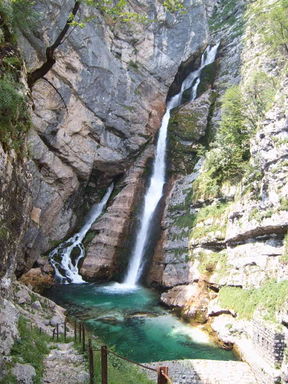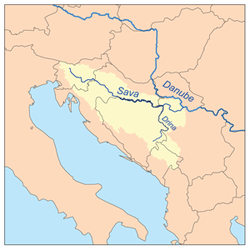Sava
| Sava | |
|---|---|
 Savica Falls, Source of the Savica |
|
| Origin | Planica valley, Slovenia |
| Mouth | Danube, Belgrade, Serbia |
| Basin countries | Slovenia, Croatia, Bosnia and Herzegovina, Serbia, Montenegro, Albania |
| Length | 990 km (with Sava Dolinka) |
| Source elevation | 1,222 m |
| Avg. discharge | 1,722 m³/s |
| Basin area | 95,719 km² |

The Sava is a river in southern Europe, a right side tributary of the Danube river at Belgrade. It is 945 km long and drains 95,719 km² of surface area. It flows through four countries: Slovenia, Croatia, Bosnia and Herzegovina (making its northern border) and Serbia.
Contents |
Length
The Sava is created by two headwaters, Sava Dolinka (left) and Sava Bohinjka (right) which join between the Slovenian towns of Lesce and Radovljica. From there until it joins the Danube at Belgrade, Serbia, it is 945 km long. (From the source of its longer headwater, Sava Dolinka, in the north-western, Alpine region of Slovenia, it measures 990 km.)
Through the Danube, it belongs to the Black Sea drainage basin, and represents the Danube's longest right tributary and second longest of all, after Tisza, as well as the richest with water, by far. It was once the longest river flowing completely within Yugoslavia proper, but after the breakup of the country in 1991, it now flows through four countries.

Origin
The 45 km long Sava Dolinka starts as the Nadiža creek in the Planica Valley under Zadnja Ponca in the Julian Alps, at the altitude of 1,222 m, near the Italian border. The stream goes underground and after 5 km breaks out again at the height of 842 m in Zelenci, near Kranjska Gora. A notable (left) tributary of it is the Radovna, which flows through a mountain gorge called Vintgar. The Sava Dolinka flows through the cities of Kranjska Gora, Gozd Martuljek, Jesenice, near Bled and Lesce. The first in a series of hydroelectric plants on the river, the Moste Hydro Power Plant (22.5 MW) is located near Žirovnica.
The shorter, 31 km long Sava Bohinjka originates under the Komarča wall at the altitude of 805 metres (2,641 ft), from underground sources drained from the Triglav Lakes Valley. Until Lake Bohinj, the river is known as the Savica ("little Sava"), and features Savica Falls ("Slap Savica") a 60 m high waterfall at its source.[1] Then the Savica River flows through the Ukanc Gorge, where a 3 MW power plant "Savica" is located. Then it flows into Lake Bohinj, creating a small delta. Afterwards, as Sava Bohinjka, it flows through Bohinjska Bistrica, Bohinjska Bela and close to Lake Bled, before it meets the Sava Dolinka near Radovljica.
From Radovljica till Dolsko to the east of Ljubljana, the Sava flows across the Ljubljana Basin. Then it enters the Central Sava Valley (Zasavje) and the Lower Sava Valley (Posavje).
Geography

The Sava drains an area of 95,719 km². The watershed reaches as far south as northern Albania (115 km²). Its average discharge at Zagreb, Croatia, is 255 m³/s, while in Belgrade its amassed to 1,722 m³/s. It also gets very deep, up to 28–30 m near villages of Hrtkovci and Bosut, in Serbia. In Serbia it creates several big river islands, including Podgorička ada near Provo and 2.7 km² Ada Ciganlija in Belgrade, the most popular Belgrade resort. The island has been connected to the right bank of the river with three causeways creating an artificial lake called "Lake Sava" with an area of 0.8 km². It is nicknamed "Belgrade Sea" and it is known to attract up to 350,000 visitors daily in the summer season.
The river has high electricity production potential in its upper course, up to 3.2 (including tributaries 4.7) billion kWh, which has not been used until lately. Apart from already mentioned two power plants, there is a third, on the Sava itself, "Medvode" (17.8 MW), near Ljubljana. There are also several hydroelectric plants under construction, of which "Vrhovo" and "Boštanj" have already begun electricity production.
The river bed is not regulated for the most of its length. That causes floods from time to time, which can affect as much as 5,000 km² of mostly very fertile land (Posavina, Sava Valley). In October 1964 Sava flooded Zagreb almost to the center, causing heavy damage and human casualties, after which high levees were built. In 1981 and April 2006, the Sava flooded lower parts of Belgrade. In 1977 & 1980 both federal and inter-republican agreements were signed about Sava's regulation, which were supposed to regulate its waters to prevent flooding, build new power stations, establish full navigation to Zagreb and ecologically protect its waters, with the final deadline being the year 2000. However, not much was done and Yugoslavia itself broke up in 1991.
East of Ljubljana, the Sava flows through a 90 km long gorge and afterwards the Brežiško - krško polje. As the Pannonian Sea receded, the Sava grew longer and longer, carving the Sava Trench (Savski rov) through which it flows to the east. Together with lower courses of Bosnian rivers which became its tributaries, it created huge floodplains. Becoming wide (at Šabac its 680 m wide, while on its mouth only 280 m), the Sava begins to meander and in history changed course many times, being pushed by the gentle slope of the Pannonian bed to the south and by the force of its many right tributaries to the north. Old riverbeds turned into swamps and ponds known as mrtvaja (dead water) and starača (old water) in Serbian. The best known is one of the biggest ponds in Serbia and one of the biggest wild birds reservation areas in Europe, Obedska bara.
Major tributaries

Right tributaries: in Slovenia: Sora, Ljubljanica, Mirna and Krka; in Croatia: Kupa and Sunja; on Croatian-Bosnian border: Una; in Bosnia: Vrbaška, Vrbas, Ukrina, Bosna, Brka, Tinja, Lukovac and Dašnica; On Bosnian-Serbian border: Drina; in Serbia: Jerez, Kolubara and Topčiderska reka;
Left tributaries: in Slovenia: Kokra, Kamniška Bistrica and Savinja; on Slovenian-Croatian border: Sotla/Sutla; in Croatia: Krapina, Lonja, Orljava; in Serbia: Bosut;
Settlements
The Sava connects three European capitals: Ljubljana in Slovenia, Zagreb in Croatia and Belgrade in Serbia. Even though Ljubljana was built on Sava's tributary Ljubljanica, as the city grew bigger it included existing villages on Sava, like Črnuče or Zalog, so the Sava now flows through Ljubljana's outskirts (in the same way Sarajevo grew over its principal river Miljacka and urbanized areas around much longer river Bosna to the west). In both Zagreb and Belgrade, it divides old and new parts of the cities (Zagreb-Novi Zagreb, Belgrade-Novi Beograd). After Ljubljana, the Sava flows through Litija and the highly industrialized region of Zasavje, including the cities of Zagorje ob Savi, Trbovlje and Hrastnik, continuing past the important railway junction of Zidani Most, and on to Radeče, Sevnica, Krško, Brežice and Čatež after which it crosses into Croatia. Passing through Zagreb, it continues through Sisak on the mouth of Kupa river, and Jasenovac, where it forms the border between Bosnia and Hercegovina and Croatia, with many dual settlements on both sides of the border: Gradiška/Stara Gradiška, Srbac/Davor, Bosanski Kobaš/Slavonski Kobaš, Bosanski Brod/Slavonski Brod, Bosanski Šamac/Slavonski Šamac, Orašje/Županja and Brčko/Gunja, soon after which it enters Serbia, where important places are: Jamena, Sremska Rača, Sremska Mitrovica, Klenak and Šabac. Then it flows through the Belgrade suburbs of Zabrežje, Obrenovac, Umka and Ostružnica until it finally empties into the Danube in Belgrade.


The Sava is navigable for 593 km, from its confluence with the Danube until the mouth of the Kupa at Sisak. Smaller crafts can navigate further upstream until Zagreb, but there are plans of dredging it to become fully navigable.[2] The river is open for international flowing and conditions with regard to available depth are varying according to the meteorological circumstances.[3]
The Sava Valley is also a natural route for land traffic, which includes the railway and highway Belgrade-Zagreb and routes of oil and gas pipelines from Croatia to Serbia. As a result of all this traffic and densely populated and industrialized areas it flows through, the river is very polluted east of Sisak and not much has been done to improve its conditions.
Tradition
"Krst pri Savici" (English: Baptism at Savica) is a heroic epic poem written by the most influential Slovenian poet France Prešeren.
Even though name Sava became very common among (and not only South) Slavs, especially as a form of personal name, either male or female, and got a 'Slavic tone', the river's name is not Slavic but Celtic and Roman in origin, who called it Savus. The old Celts associated their river goddess Adsullata with the river Savus.
Geopolitics
The Sava marks the north-western boundary of the Balkan peninsula (Southeast Europe). All lands north of the Sava (eg. Vojvodina, northern Croatia, most of Slovenia, etc.) are geographically within Central Europe. With the changes of the political climate, the boundary also changed. In Yugoslav times it was considered that the whole Sava is the border (thus promoting mutuality among different Yugoslav nations), which placed even parts of Italy (Trieste area) as a part of the Balkan peninsula. After splitting from Yugoslavia, the border was set by some to be the Sava-Kupa line (Kupa forms a part of southern Slovenian border, with Croatia), and then to the Adriatic; placing Belgrade in the Balkans, but Zagreb and Ljubljana outside the Balkans.
References
- Mala Prosvetina Enciklopedija, Third edition (1985), Vol. I (for Balkan peninsula) & III (for Sava river); Prosveta; ISBN 86-07-00001-2
- Jovan Đ. Marković (1990): Enciklopedijski geografski leksikon Jugoslavije; Svjetlost-Sarajevo; ISBN 86-01-02651-6
Footnotes
- ↑ Baedeker, Karl (1879) "Terglou: The Valley of the Wocheiner Save" The Eastern Alps: Including the Bavarian Highlands, the Tyrol, Salzkammergut, Styria, and Carinthia (4th ed.) Dulau and Co., London, p. 353, OCLC 4018143
- ↑ Pulić, Marija (2005-08-31). "Milijardu eura za "Zagreb na Savi"" (in Croatian). Vjesnik. http://www.vjesnik.hr/Html/2005/08/31/Clanak.asp?r=unu&c=1. Retrieved 2008-07-27.
- ↑ "NoorderSoft Waterways Database". http://www.noordersoft.com/indexen.html.
|
||||||||||||||||||||

